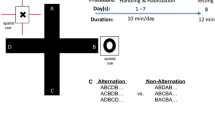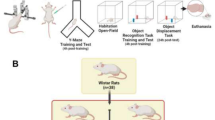Abstract
Aims/hypothesis
Children with diabetes may display cognitive alterations although vascular disorders have not yet appeared. Variations in glucose levels together with relative insulin deficiency in treated type 1 diabetes have been reported to impact brain function indirectly through dysregulation of the hypothalamus–pituitary–adrenal axis. We have recently shown that enhancement of glucocorticoid levels in children with type 1 diabetes is dependent not only on glucocorticoid secretion but also on glucocorticoid tissue concentrations, which is linked to 11β-hydroxysteroid dehydrogenase type 1 (11β-HSD1) activity. Hypothalamus–pituitary–adrenal axis dysfunction and memory alteration were further dissected in a juvenile rat model of diabetes showing that excess 11β-HSD1 activity within the hippocampus is associated with hippocampal-dependent memory deficits. Here, to investigate the causal relationships between diabetes, 11β-HSD1 activity and hippocampus-dependent memory deficits, we evaluated the beneficial effect of 11β-HSD1 inhibition on hippocampal-related memory in juvenile diabetic rats. We also examined whether diabetes-associated enhancement of hippocampal 11β-HSD1 activity is due to an increase in brain glucose concentrations and/or a decrease in insulin signalling.
Methods
Diabetes was induced in juvenile rats by daily i.p. injection of streptozotocin for 2 consecutive days. Inhibition of 11β-HSD1 was obtained by administrating the compound UE2316 twice daily by gavage for 3 weeks, after which hippocampal-dependent object location memory was assessed. Hippocampal 11β-HSD1 activity was estimated by the ratio of corticosterone/dehydrocorticosterone measured by LC/MS. Regulation of 11β-HSD1 activity in response to changes in glucose or insulin levels was determined ex vivo on acute brain hippocampal slices. The insulin regulation of 11β-HSD1 was further examined in vivo using virally mediated knockdown of insulin receptor expression specifically in the hippocampus.
Results
Our data show that inhibiting 11β-HSD1 activity prevents hippocampal-related memory deficits in diabetic juvenile rats. A significant increase (53.0±9.9%) in hippocampal 11β-HSD1 activity was found in hippocampal slices incubated in high glucose conditions (13.9 mmol/l) vs normal glucose conditions (2.8 mmol/l) without insulin. However, 11β-HSD1 activity was not affected by variations in insulin concentration either in the hippocampal slices or after a decrease in hippocampal insulin receptor expression.
Conclusions/interpretation
Together, these data demonstrate that an increase in 11β-HSD1 activity contributes to memory deficits observed in juvenile diabetic rats and that an excess of hippocampal 11β-HSD1 activity stems from high glucose levels rather than insulin deficiency. 11β-HSD1 might be a therapeutic target for treating cognitive impairments associated with diabetes.
Graphical Abstract





Similar content being viewed by others
Abbreviations
- AAV:
-
Adeno-associated virus
- Cs:
-
Corticosterone
- CTL:
-
Control group treated by vehicle
- CTL+UE:
-
Control group treated by UE
- D:
-
Diabetic group treated by vehicle
- DHC:
-
Dehydrocorticosterone
- D+UE:
-
Diabetic group treated by UE
- fEPSP:
-
Field excitatory post-synaptic potential
- GC:
-
Glucocorticoids
- Hippo-CTL:
-
Wild-type mice
- Hippo-InsRKD:
-
Mice with specific InsR knockdown in the hippocampus
- 11β-HSD1:
-
11β-Hydroxysteroid dehydrogenase type 1
- InsR:
-
Insulin receptor
- InsRlox /lox :
-
Insulin receptorlox/lox
- NMDG:
-
N-Methyl-d-glucamine
- OLM:
-
Object location memory
- PFA:
-
Paraformaldehyde
- PPP:
-
Pentose phosphate pathway
- STZ:
-
Streptozotocin
- UE:
-
UE2316
References
Brands AMA, Biessels GJ, de Haan EHF, Kappelle LJ, Kessels RPC (2005) The effects of type 1 diabetes on cognitive performance. Diabetes Care 28(3):726–735. https://doi.org/10.2337/diacare.28.3.726
Shalimova A, Graff B, Gąsecki D et al (2019) Cognitive dysfunction in type 1 diabetes mellitus. J Clin Endocrinol Metab 104(6):2239–2249. https://doi.org/10.1210/jc.2018-01315
McCrimmon RJ, Ryan CM, Frier BM (2012) Diabetes and cognitive dysfunction. Lancet 379(9833):2291–2299. https://doi.org/10.1016/S0140-6736(12)60360-2
Creo AL, Cortes TM, Jo HJ et al (2021) Brain functions and cognition on transient insulin deprivation in type 1 diabetes. JCI Insight 6(5):e144014. https://doi.org/10.1172/jci.insight.144014
Silver I, Erecinska M (1994) Extracellular glucose concentration in mammalian brain: continuous monitoring of changes during increased neuronal activity and upon limitation in oxygen supply in normo-, hypo-, and hyperglycemic animals. J Neurosci 14(8):5068–5076. https://doi.org/10.1523/JNEUROSCI.14-08-05068.1994
Gaudieri PA, Chen R, Greer TF, Holmes CS (2008) Cognitive function in children with type 1 diabetes. Diabetes Care 31(9):1892–1897. https://doi.org/10.2337/dc07-2132
Litmanovitch E (2015) Short and long term neuro-behavioral alterations in type 1 diabetes mellitus pediatric population. WJD 6(2):259. https://doi.org/10.4239/wjd.v6.i2.259
Magariños AM, McEwen BS (2000) Experimental diabetes in rats causes hippocampal dendritic and synaptic reorganization and increased glucocorticoid reactivity to stress. Proc Natl Acad Sci USA 97(20):11056–11061. https://doi.org/10.1073/pnas.97.20.11056
MacLullich AMJ, Seckl JR (2008) Diabetes and cognitive decline: are steroids the missing link? Cell Metab 7(4):286–287. https://doi.org/10.1016/j.cmet.2008.03.012
de Quervain D, Schwabe L, Roozendaal B (2017) Stress, glucocorticoids and memory: implications for treating fear-related disorders. Nat Rev Neurosci 18(1):7–19. https://doi.org/10.1038/nrn.2016.155
Revsin Y, Rekers NV, Louwe MC et al (2009) Glucocorticoid receptor blockade normalizes hippocampal alterations and cognitive impairment in streptozotocin-induced type 1 diabetes mice. Neuropsychopharmacol 34(3):747–758. https://doi.org/10.1038/npp.2008.136
Stranahan AM, Arumugam TV, Cutler RG, Lee K, Egan JM, Mattson MP (2008) Diabetes impairs hippocampal function through glucocorticoid-mediated effects on new and mature neurons. Nat Neurosci 11(3):309–317. https://doi.org/10.1038/nn2055
Zuo Z-F, Wang W, Niu L et al (2011) RU486 (mifepristone) ameliorates cognitive dysfunction and reverses the down-regulation of astrocytic N-myc downstream-regulated gene 2 in streptozotocin-induced type-1 diabetic rats. Neuroscience 190:156–165. https://doi.org/10.1016/j.neuroscience.2011.06.025
Marissal-Arvy N, Moisan M-P (2022) Diabetes and associated cognitive disorders: role of the hypothalamic-pituitary adrenal axis. Metab Open 15:100202. https://doi.org/10.1016/j.metop.2022.100202
Barat P, Brossaud J, Lacoste A et al (2013) Nocturnal activity of 11β-hydroxy steroid dehydrogenase type 1 is increased in type 1 diabetic children. Diabetes Metab 39(2):163–168. https://doi.org/10.1016/j.diabet.2012.10.001
Brossaud J, Corcuff J-B, Vautier V et al (2021) Altered cortisol metabolism increases nocturnal cortisol bioavailability in prepubertal children with type 1 diabetes mellitus. Front Endocrinol 12:742669. https://doi.org/10.3389/fendo.2021.742669
Marissal-Arvy N, Campas M-N, Semont A et al (2018) Insulin treatment partially prevents cognitive and hippocampal alterations as well as glucocorticoid dysregulation in early-onset insulin-deficient diabetic rats. Psychoneuroendocrinology 93:72–81. https://doi.org/10.1016/j.psyneuen.2018.04.016
Soltesz G, Patterson C, Dahlquist G, EURODIAB Study Group (2007) Worldwide childhood type 1 diabetes incidence – what can we learn from epidemiology? Pediatr Diabetes 8(Suppl 6):6–14. https://doi.org/10.1111/j.1399-5448.2007.00280.x
Sarabdjitsingh RA, Zhou M, Yau JLW et al (2014) Inhibiting 11β-hydroxysteroid dehydrogenase type 1 prevents stress effects on hippocampal synaptic plasticity and impairs contextual fear conditioning. Neuropharmacology 81:231–236. https://doi.org/10.1016/j.neuropharm.2014.01.042
Alteba S, Korem N, Akirav I (2016) Cannabinoids reverse the effects of early stress on neurocognitive performance in adulthood. Learn Mem 23(7):349–358. https://doi.org/10.1101/lm.041608.116
Ennaceur A, Neave N, Aggleton JP (1997) Spontaneous object recognition and object location memory in rats: the effects of lesions in the cingulate cortices, the medial prefrontal cortex, the cingulum bundle and the fornix. Exp Brain Res 113(3):509–519. https://doi.org/10.1007/PL00005603
Mumby DG, Gaskin S, Glenn MJ, Schramek TE, Lehmann H (2002) Hippocampal damage and exploratory preferences in rats: memory for objects, places, and contexts. Learn Mem 9(2):49–57. https://doi.org/10.1101/lm.41302
Paxinos G, Franklin KBJ (2019) Paxinos and Franklin’s the mouse brain in stereotaxic coordinates, 5th edn. Academic Press, Cambridge, MA
Titone R, Zhu M, Robertson DM (2018) Insulin mediates de novo nuclear accumulation of the IGF-1/insulin hybrid receptor in corneal epithelial cells. Sci Rep 8(1):4378. https://doi.org/10.1038/s41598-018-21031-7
Park J, Li J, Mayer JP et al (2022) Activation of the insulin receptor by an insulin mimetic peptide. Nat Commun 13(1):5594. https://doi.org/10.1038/s41467-022-33274-0
Thomazeau A, Bosch-Bouju C, Manzoni O, Layé S (2016) Nutritional n-3 PUFA deficiency abolishes endocannabinoid gating of hippocampal long-term potentiation. Cereb Cortex 27(4):2571–2579. https://doi.org/10.1093/cercor/bhw052
Reusch CE, Liehs MR, Hoyer M, Vochezer R (1993) Fructosamine a new parameter for diagnosis and metabolic control in diabetic dogs and cats. J Vet Int Med 7(3):177–182. https://doi.org/10.1111/j.1939-1676.1993.tb03183.x
Sooy K, Noble J, McBride A et al (2015) Cognitive and disease-modifying effects of 11β-hydroxysteroid dehydrogenase type 1 inhibition in male Tg2576 mice, a model of Alzheimer’s disease. Endocrinology 156(12):4592–4603. https://doi.org/10.1210/en.2015-1395
Yau JLW, Seckl JR (2012) Local amplification of glucocorticoids in the aging brain and impaired spatial memory. Front Aging Neurosci 4:24. https://doi.org/10.3389/fnagi.2012.00024
Bhatt S, Hillmer AT, Rusowicz A et al (2021) Imaging brain cortisol regulation in PTSD with a target for 11β-hydroxysteroid dehydrogenase type 1. J Clin Investig 131(20):e150452. https://doi.org/10.1172/JCI150452
Webster SP, McBride A, Binnie M et al (2017) Selection and early clinical evaluation of the brain-penetrant 11β-hydroxysteroid dehydrogenase type 1 (11β-HSD1) inhibitor UE2343 (XanamemTM): discovery/clinical evaluation of 11β-HSD1 inhibitor UE2343. Br J Pharmacol 174(5):396–408. https://doi.org/10.1111/bph.13699
Bini J, Bhatt S, Hillmer AT et al (2020) Body mass index and age effects on brain 11β-hydroxysteroid dehydrogenase type 1: a positron emission tomography study. Mol Imaging Biol 22(4):1124–1131. https://doi.org/10.1007/s11307-020-01490-z
Sandeep TC, Yau JLW, MacLullich AMJ et al (2004) 11β-Hydroxysteroid dehydrogenase inhibition improves cognitive function in healthy elderly men and type 2 diabetics. Proc Natl Acad Sci USA 101(17):6734–6739. https://doi.org/10.1073/pnas.0306996101
Gregory S, Hill D, Grey B et al (2020) 11β-Hydroxysteroid dehydrogenase type 1 inhibitor use in human disease-a systematic review and narrative synthesis. Metabolism 108:154246. https://doi.org/10.1016/j.metabol.2020.154246
Dodd S, Skvarc DR, Dean OM, Anderson A, Kotowicz M, Berk M (2022) Effect of glucocorticoid and 11β-hydroxysteroid-dehydrogenase type 1 (11β-HSD1) in neurological and psychiatric disorders. Int J Neuropsychopharmacol 25(5):387–398. https://doi.org/10.1093/ijnp/pyac014
Liu Y-J, Nakagawa Y, Nasuda K, Saegusa H, Igarashi Y (1996) Effect of growth hormone, insulin and dexamethasone on 11 β -hydroxysteroid dehydrogenase activity on a primary culture of rat hepatocytes. Life Sci 59(3):227–234. https://doi.org/10.1016/0024-3205(96)00288-3
Fan Z, Du H, Zhang M, Meng Z, Chen L, Liu Y (2011) Direct regulation of glucose and not insulin on hepatic hexose-6-phosphate dehydrogenase and 11β-hydroxysteroid dehydrogenase type 1. Mol Cell Endocrinol 333(1):62–69. https://doi.org/10.1016/j.mce.2010.12.010
Yao F, Chen L, Fan Z et al (2017) Interplay between H6PDH and 11β-HSD1 implicated in the pathogenesis of type 2 diabetes mellitus. Bioorg Med Chem Lett 27(17):4107–4113. https://doi.org/10.1016/j.bmcl.2017.07.043
Dzyakanchuk AA, Balázs Z, Nashev LG, Amrein KE, Odermatt A (2009) 11β-Hydroxysteroid dehydrogenase 1 reductase activity is dependent on a high ratio of NADPH/NADP+ and is stimulated by extracellular glucose. Mol Cell Endocrinol 301(1–2):137–141. https://doi.org/10.1016/j.mce.2008.08.009
Qi W, Zhong L, Li X et al (2012) Hyperglycemia induces the variations of 11 β -hydroxysteroid dehydrogenase type 1 and peroxisome proliferator-activated receptor-γ expression in hippocampus and hypothalamus of diabetic rats. Exp Diabetes Res 2012:107130. https://doi.org/10.1155/2012/107130
Rebelos E, Rinne JO, Nuutila P, Ekblad LL (2021) Brain glucose metabolism in health, obesity, and cognitive decline—does insulin have anything to do with it? A narrative review. J Clin Med 10(7):1532. https://doi.org/10.3390/jcm10071532. (1-16)
Lavery GG, Walker EA, Draper N et al (2006) Hexose-6-phosphate dehydrogenase knock-out mice lack 11β-hydroxysteroid dehydrogenase type 1-mediated glucocorticoid generation. J Biol Chem 281(10):6546–6551. https://doi.org/10.1074/jbc.M512635200
Takahashi S, Izawa Y, Suzuki N (2012) Astroglial pentose phosphate pathway rates in response to high-glucose environments. ASN Neuro 4(2):e00078. https://doi.org/10.1042/AN20120002
Author information
Authors and Affiliations
Corresponding author
Ethics declarations
Acknowledgements
The development of UE2316 was funded by the Wellcome Trust.
Data availability
The data are available on request from the authors.
Funding
This work was supported by a grant from SFEDP (Société Française d’Endocrinologie et Diabétologie Pédiatrique).
Authors’ relationships and activities
BRW and SPW are inventors on relevant patents owned by the University of Edinburgh and licensed to Actinogen Medical Ltd. The authors declare that there are no other relationships or activities that might bias, or be perceived to bias, their work.
Contribution statement
JB, CB-B, XF, PB, J-BC and M-PM contributed to the conception and design of the study. JB, J-CH, NM-A, M-NC-L, CB-B and M-PM acquired the data. JB, CB-B, SPW, BRW, XF, GF and M-PM analysed and interpreted the data. JB, CB-B, J-CH, XF and M-PM drafted the manuscript and JB, CB-B, NM-A, M-NC-L, SPW, BRW, GF, PB, J-BC and M-PM revised it. All authors approved the manuscript. JB and M-PM are the guarantors of this work.
Additional information
Publisher's note
Springer Nature remains neutral with regard to jurisdictional claims in published maps and institutional affiliations.
Supplementary Information
Below is the link to the electronic supplementary material.
Rights and permissions
Springer Nature or its licensor (e.g. a society or other partner) holds exclusive rights to this article under a publishing agreement with the author(s) or other rightsholder(s); author self-archiving of the accepted manuscript version of this article is solely governed by the terms of such publishing agreement and applicable law.
About this article
Cite this article
Brossaud, J., Bosch-Bouju, C., Marissal-Arvy, N. et al. Memory deficits in a juvenile rat model of type 1 diabetes are due to excess 11β-HSD1 activity, which is upregulated by high glucose concentrations rather than insulin deficiency. Diabetologia 66, 1735–1747 (2023). https://doi.org/10.1007/s00125-023-05942-3
Received:
Accepted:
Published:
Issue Date:
DOI: https://doi.org/10.1007/s00125-023-05942-3




